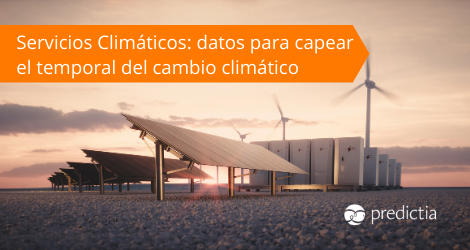Climate change influences our day to day lives: from direct consecuences, like crops affected by increasing heat waves, to unexpected effects like the diminishing productivity of food security inspectors. Over the last decades, this situation has created a strong need for reliable climate services: tools that facilitate the access to climate information. The World Meteorological Organisation classifies Climate Services as "decision aides derived from climate information, helping individuals and organizations in society to make improved ex-ante decisions". Such tools improve the decision-making process of many sectors—Agriculture, transport routes, renewable energies or urban planning, among others. Currently, the demand for climate services is rising and, just in Europe, all these sectors spend over € 7 billion in climate services, but... what do these services provide, and why are they necessary?
Energy: will the windmills stay productive in 30 years?
On a daily basis, renewable energies depend upon the weather's variability: intensity of sun radiation, wind speed, amount of rain… Wind and solar farms estimate each day the amount of energy they will produce, and provide that estimate to energy regulators, so the electrical grid works in a stable and reliable way. And this systems relies on a bidding system in which, if the estimations fail, the energy provider gets penalised. Therefore, it’s important for energy providers to have short-term weather predictions that are highly reliable, like the ones we provide, using the WRF model.
However, what happens in the long term? Taking into account that windmills have a lifespan of 20 years, a solar panel between 20 and 30 years, and a hydropower station lives for 50 years or more, deciding where to place windmills, solar panels and other generators is not easy. The location must suffer the least environmental impact, and must remain usable over several decades. Climate projections, thanks to techniques like downscaling and Bias Adjustment, allow to obtain localised climate simulations for the next 100 years.
However, the raw outputs of the model cannot be used directly. Different energy sectors need different climate indexes of interests: clearness index for solar panels, average wind speeds for windmills, or precipitation levels and dry years occurrence for hydropower. This enables them to check whether their location will remain usable for energy production over the upcoming years... and therefore, profitable.
Agriculture: adaptations to climate
Agriculture is one of the basic pillars of the economy. In Europe, it generated a gross value of 181 billion € just in 2018, and entire regions depend on this sector. For example, in the wine region of La Rioja (Spain), viticulture and oenology represents 17.7% of their GDP. Just in viticulture, there is a lot of efforts devoted to adapt and mitigate the impacts that climate change is having on the sector: vines that can endure different temperature ranges, that are more resistant to plagues or use less water to grow. Depending on their location, each winery faces different climate challenges. And not only the wine sector. Rice, wheat, corn, soy… they are the main agricultural products worldwide, and some of the most exposed to climate change.
To take a data-based decisions on how to adapt, it is crucial to have a good estimation on how the weather will be in the future. From 50 years projections, that can guide the biotechnological research needed on the long run, to subseasonal to seasonal simulations—covering time ranges between 2 weeks up to 2 months in advance—that let farmers prepare for the near future.These last ones are especially relevant, as they cover the gap between weather and climate predictions, and enable farmers, insurace companies and other stakeholders to take data-based decisions to protect their business. In this sense projects like EUPORIAS, in which we took part, have enhances the climate simulations that cover the space between seasonal and decadal projections.
Water management: handling the risk
Entire cities like Venice are threatened by the rising sea levels, putting hundreds of years of history at risk. Floods like the ones Central Europe suffered in 2002, that impacted over 9 countries. Over 153 million citizens will be exposed to draughts each year, just within the European Union, throughout the 21st century, according to European Commission estimations. With provisions such as these, water managers are need detailed information to plan ahead.
Water management has several fronts in which climate services have become essential. From mitigation and adaptation measures for draughts, to actionable flood risk maps that can guide urban planning for more resilient societies. In addition, for those working on disaster risk reduction, climate services can provide historical data analysis, enhancing the response of emergency responders to extreme weather events. The applications of climate data are limitless, and vary heavily depending on the location and concrete meteorological event (floods, draughts. floods...), and therefore have to be carefully developed tailored to each case.
Forestry: managing nature against climate change
In Europe, two thirds of forests are located in just 6 countries: Sweden, Finland, Spain, France, Germany and Poland. Some of these countries exhibit some of the highest indexes of exposure to climate change. To reduce this exposure, forests (when managed properly), can play a relevant role in adaptation and mitigation efforts: they regulate ecosystems, protect biodiversity, and are an essential part of the carbon cycle. In addition, they make a sustainable model that contributes to a green economy. But in order to do so, forest management must rely on data, taking into account climate projections that estimate the impact of draughts, or allow the design of societal strategies that use forests to mitigate the effects of climate change.
These are just some examples of how climate services contribute to many different sectors. If you are interested in climate data, contact us: we are open to hear what you need and develop a solution that fits your needs, like we have already done for businesses like Iberdrola and EDP, public administrations such as FAO or the regional Government of Cantabria, or research centres like IHCantabria.
